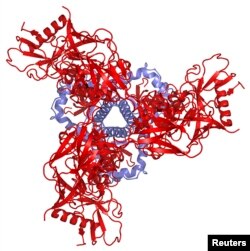New research that sheds light on the methods and machinery used by HIV to infect cells provides insight into the tricky virus that potentially could guide the development of a vaccine against the virus that causes AIDS, according to U.S. government and other scientists.
Separate studies published on Wednesday describe in detail the structure and dynamics of the spike on the surface of the human immunodeficiency virus that it employs to fuse with and enter cells.
The researchers expressed hope that the information can provide a road map for a potential vaccine designed to keep the spike in a "closed" state to prevent the virus from successfully infecting cells.
"We can expect a lot of activities being devoted to that goal," Yale University virologist Walther Mothes, one of the researchers, said, calling the new findings "a major step forward for drug and vaccine design."
Another researcher, structural biologist Jason Gorman of the Vaccine Research Center at the U.S. National Institute of Allergy and Infectious Diseases, expressed optimism "that this new information will pave the way for a vaccine. Of course, there are always many barriers to overcome."
The research, published in the journals Nature and Science, may point to a way through a vaccine or perhaps new drugs to enable the immune system - the body's natural defense system - to zero in on HIV and block its ability to infect cells.
The research revealed the detailed structure of the spikes on the surface of HIV as well as details on how the spike rearranges itself into three different configurations.
Three sets of a pair of molecules make up each spike, and the spike alters its shape before and during cell binding, the researchers said. The configuration that the spikes most often assume is the "closed" state, which is particularly difficult for the immune system to detect. But in that form the spike also has difficulty infecting a cell.
The spikes need to be in their "open" state in order to fuse with a cell and infect it. But that state exposes parts of the virus that may be more vulnerable to antibodies, the protective proteins produced by the immune system in response to an invader like a virus.
As a result, the spike usually takes its "closed" form and opens for a short time, making it hard for the immune system to find and attack the virus, the researchers said. A class of antibodies called "broadly neutralizing antibodies" are able to keep the spike closed and curb further cell infection by HIV but are rarely found in HIV-infected people.
Scientists have tried for decades to develop a safe and effective vaccine to prevent AIDS, caused by HIV infection. HIV is complex and extremely changeable, thwarting the immune system at nearly every turn.
Gorman said the work provided atomic-level details of the full spike that are critical for allowing scientists to try to deprive it of its flexibility "and lock it into the closed state that elicits and is recognized by broadly neutralizing antibodies."













